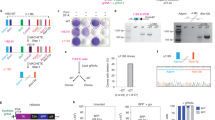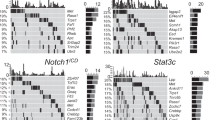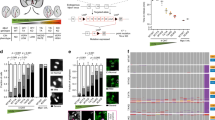Abstract
Genotoxic carcinogens exert their tumorigenic effects in part by inducing genomic instability. We recently showed that loss of heterozygosity (LOH) on chromosome 12 associates significantly with the induction of chromosome instability (CIN) by the likely human lung carcinogen 4-(methylnitrosamino)-1-(3-pyridyl)-1-butanone (NNK) and vinyl carbamate (VC) during mouse lung carcinogenesis. Here, we demonstrate the carcinogen specificity of this event and its effect on lung tumor evolution. LOH on chromosome 12 was observed in 45% of NNK-induced, 59% of VC-induced, 58% of aflatoxin B1 (AFB1)-induced, 14% of N-ethyl-N-nitrosourea (ENU)-induced and 12% of spontaneous lung adenocarcinomas. The frequency of LOH in each of the carcinogen-induced groups, except ENU, was significantly higher than in the spontaneous group (P<0.001). Deletion mapping revealed four potential candidate regions of 1–4 centiMorgans suspected to contain targeted tumor suppressor genes, with at least one expected to have a role in CIN. The relationship between LOH on chromosome 12 and additional chromosomal alterations occurring during lung tumor progression was also examined. LOH on chromosomes 1 and 14 were moderately frequent during malignant progression in tumors from all treatment groups, occurring in 21–35 and 18–33% of tumors. However, these alterations showed significant concurrence with LOH on chromosome 12 in VC-, NNK- and AFB1-induced tumors (P<0.05). The results suggest that a carcinogen-selective mechanism of lung cancer induction involves the frequent inactivation of genes on chromosome 12, including a stability gene that evidently promotes the evolutionary selection of additional chromosomal alterations during malignant progression.
This is a preview of subscription content, access via your institution
Access options
Subscribe to this journal
Receive 50 print issues and online access
$259.00 per year
only $5.18 per issue
Buy this article
- Purchase on Springer Link
- Instant access to full article PDF
Prices may be subject to local taxes which are calculated during checkout



Similar content being viewed by others
References
Anderson LM . (1978). Cancer Lett., 5, 55–59.
Ballering LA, Nivard MJ and Vogel EW . (1997). Environ. Mol. Mutagen., 30, 321–329.
Bardelli A, Cahill DP, Lederer G, Speicher MR, Kinzler KW, Vogelstein B and Lengauer C. . (2001). Proc. Natl. Acad. Sci. USA, 98, 5770–5775.
Bernstein C, Bernstein H, Payne CM and Garewal H . (2002). Mutat. Res., 511, 145–178.
Bishop AJ, Barlow C, Wynshaw-Boris AJ and Schiestl RH . (2000). Cancer Res., 60, 395–399.
Branch P, Hampson R and Karran P . (1995). Cancer Res., 55, 2304–2309.
Branstetter DG, Stoner GD, Schut HA, Senitzer D, Conran PB and Goldblatt PJ . (1987). Cancer Res., 47, 348–352.
Breivik J . (2001). Proc. Natl. Acad. Sci. USA, 98, 5379–5381.
Breivik J and Gaudernack G . (1999). Semin. Cancer Biol., 9, 245–254.
Claij N, van der Wal A, Dekker M, Jansen L and te Riele H . (2003). Cancer Res., 63, 2062–2066.
Cheng KC and Loeb LA . (1997). Curr. Top. Microbiol. Immunol., 221, 5–18.
de Vries A . (1995). Nature, 377, 169–173.
Dipple A . (1995). Carcinogenesis (Lond.), 16, 437–441.
Fijneman RJ, Jansen RC, van der Valk MA and Demant P . (1998). Cancer Res., 58, 4794–4798.
Gerard L, Zochbauer-Muller S, Virmani AK, Gadzar AF and Minna JD . (2000). Cancer Res., 60, 4894–4906.
Gisselsson D . (2003). Adv. Cancer Res., 187, 1–29.
Hecht SS . (1999). Mutat. Res., 424, 127–142.
Hecht SS, Chen CB, Hirota N, Ornaf RM, Tso TC and Hoffmann D . (1978). J. Natl. Cancer Inst., 60, 819–824.
Hegi MD, Devereux TR, Dietrich WF, Cochran CJ, Lander ES, Foley J F, Maronpot RR, Anderson MW and Wiseman RW . (1994). Cancer Res., 54, 6257–6264.
Herzog CR, Chen B, Wang Y, Schut HAJ and You M . (1996). Mol. Carcinogen., 16, 83–90.
Herzog CR, Devereux TR, Pittman B and You M . (2002). Cancer Res., 62, 6424–6429.
Herzog CR, Lubet RA and You M . (1997). J. Cell. Biochem., 28/29, 49–63.
Herzog CR, Noh S, Lantry LE, Guan KL and You M. . (1999). Mol. Carcinogen., 25, 92–98.
Hoeijmakers JJJ . (2001). Nature, 411, 366–374.
Lengauer C, Kinzler KW and Vogelstein B . (1998). Nature, 396, 643–649.
Jallepalli PV and Lengauer C . (2001). Nat.Rev., 1, 109–117.
Lehmann AR . (2001). Genes Dev., 15, 15–23.
Loeb LA . (1998). Adv. Cancer Res., 72, 25–56.
Masuda A and Takahashi T . (2002). Oncogene, 21, 6884–6897.
Michel LS, Liberal V, Chatterjee A, Kirchwegger R, Pasche B, Gerald W, Dobles M, Sorger PK, Murty VVVS and Benezra R . (2001). Nature, 409, 355–359.
Minna JD . (1993). Chest, 103, 449s–456s.
Osada H and Takahashi T . (2002). Oncogene, 21, 7421–7434.
Pataer A, Nishimura M, Kamoto T, Ichioka K, Sato M and Hiai H. . (1997). Cancer Res., 57, 2904–2908.
Powell SN, Willers H and Xia F . (2002). Mol. Cell., 10, 1262–1263.
Ricordy R, Gensabella G, Cacci E and Augusti-Tocco G . (2002). Mutagenesis, 17, 241–249.
Sargent LM, Senft JR, Lowery DT, Jefferson AM, Tyson FL, Malkinson AM, Coleman AE and Reynolds SH . (2002). Cancer Res., 62, 1152–1157.
Shen HM, Ong CN, Lee BL and Shi CY . (1995). Carcinogenesis (Lond.), 16, 419–422.
Sipowicz MA, Amin S, Desai D, Kasprazak KS and Anderson LM . (1997). Cancer Lett., 117, 87–91.
Tam AS, Foley JF, Devereux TR, Maronpot RR and Massey TE . (1999). Cancer Res., 59, 3634–3640.
Trushin N, Rivenson A and Hecht SS . (1994). Cancer Res., 54, 1205–1211.
Wong MP, Lam WK, Wang E, Chiu SW, Lam CL and Chung LP . (2002). Cancer Res., 62, 4464–4468.
Acknowledgements
This work was supported by the NIH Grant CA17613 (C Herzog). We thank Dr Basil Rigas for use of the imaging equipment and software, and Drs Frederick Tyson and Alvin Malkinson for the cell lines.
Author information
Authors and Affiliations
Corresponding author
Rights and permissions
About this article
Cite this article
Herzog, C., Bodon, N., Pittman, B. et al. Carcinogen-specific targeting of chromosome 12 for loss of heterozygosity in mouse lung adenocarcinomas: implications for chromosome instability and tumor progression. Oncogene 23, 3033–3039 (2004). https://doi.org/10.1038/sj.onc.1207431
Published:
Issue Date:
DOI: https://doi.org/10.1038/sj.onc.1207431



